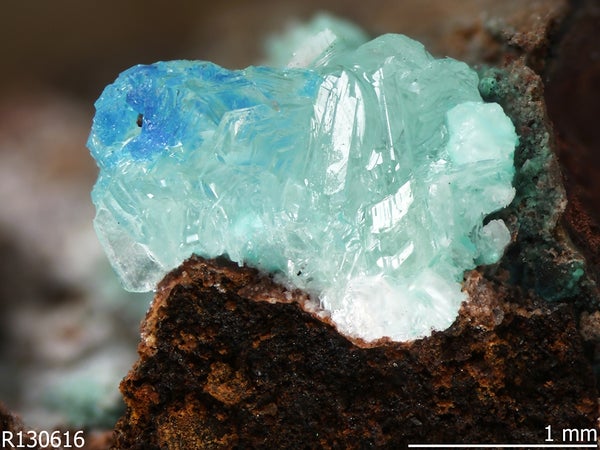Humans have dramatically changed Earth’s surface. Satellite images show New York City’s sparkling lights at night and the Great Wall of China during the day. But we have also produced signatures in the strata beneath our feat that can’t be seen so readily, like the plastic that litters the ocean floor and a strong radiation signal produced by atomic bomb tests. For many scientists, this kind of evidence is enough to formally declare a new geologic epoch—one that will be visible in the layers of sediment millions of years from now. And new research, published March 1 in American Mineralogist, adds another layer to the argument for the so-called Anthropocene: man-made minerals.
Robert Hazen, a mineralogist at the Carnegie Institution for Science, and his colleagues tallied up the number of minerals on Earth only to discover that a large number have been created, thanks to human activities. Although minerals, by definition, must form via natural processes, Hazen’s team discovered 208 minerals mediated by humans—they did form naturally but in places such as man-made mines, where unnatural humidity or fires from mining operations created new minerals along the mine walls. Other examples might be even harder to find, unless you are a deep-sea diver; when bronze or brass artifacts sink in a shipwreck, for example, they interact with the seafloor to create novel, man-mediated minerals.
Perhaps more striking are mineral-like compounds—substances that would be characterized as minerals if they were not completely man-made (rather than human-mediated). Hazen’s team created a long list of these as well—everything from synthetic rubies and diamonds to ceramics, brick, cement, batteries and certain components of cell phones—and they suspect there are hundreds of thousands of varieties, too many for them to count.
On supporting science journalism
If you're enjoying this article, consider supporting our award-winning journalism by subscribing. By purchasing a subscription you are helping to ensure the future of impactful stories about the discoveries and ideas shaping our world today.
To put that number in perspective: Roughly 2.4 billion years ago a great deal of oxygen arose in our atmosphere, causing the number of minerals to skyrocket from around 2,000 to 5,000 with the addition of so many oxide versions. Hazen’s work now shows human events trump that so-called Great Oxidation Event, which was previously the largest known increase in minerals (taking the broad sense of the term). “There are so many things that we produce that are mineral-like that we have really changed the sedimentary horizon in which we are now living,” Hazen says.
Not only have humans greatly increased the diversity of minerals—again using the term to mean naturally occurring, human-mediated and man-made—they have done so rapidly. It took some two billion years to create thousands of minerals during the Great Oxidation Event, but the latest increase of hundreds of thousands has mostly occurred since the industrial revolution. It is the fastest rate of new mineral production in Earth’s history, Hazen says. And that is key: “The Anthropocene isn't simply saying that humans have influenced strata,” adds Jan Zalasiewicz, a geologist at the University of Leicester and chair of the Anthropocene Working Group, who was not involved in the study. “It's a symbol of the scale, variety and trajectory of those changes.” Just think of any graph that shows the steep climb of atmospheric carbon dioxide levels over the past few decades, the blink of an eye geologically speaking. It is that kind of growth (be it of carbon dioxide or another signature) that defines the Anthropocene, Zalasiewicz says. “One of the most distinctive vertical lines on the graph is the growth of mineral species,” he says. “It’s one of the most striking changes.”
Such dramatic changes will not go unnoticed if a future geologist finds herself digging up layers of sediment from an ancient city. “These are the real global marker of our age,” Hazen says. Not only because a city’s infrastructure contains many of these man-made minerals but because it also contains natural minerals that were quarried in locations across the world, creating concentrations that would not be found naturally. Even if sea levels rise 300 feet and cover coastal cities, those minerals will still be visible in the sedimentary record. That’s because landmarks like the Washington Monument and the Smithsonian will collapse into piles of rubble—signatures that are later preserved as highly unusual lens-shaped pockets underground, distinct from their surroundings in both shape and minerals. The Washington Monument, for example, will eventually be a lens-shaped pocket composed of limestone where no other limestone is found. And the pocket that was once the Smithsonian will contain so many rare minerals that they could not possibly have formed so close together in nature. To boot, they will be surrounded by the vast array of the man-made minerals we use every day. “There is nothing at all like this in the geology of the past 4.5 billion years on Earth,” Zalasiewicz says. “It is tragically different.”
